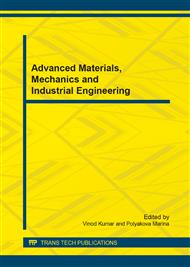[1]
W. T. Liberson, H. J. Holmquest, D. Scot, and M. Dow, Functional electrotherapy: stimulation of the peroneal nerve synchronized with the swing phase of the gait of hemiplegic patients, Arch. Phys. Med. Rehabil., vol. 42, p.101–105, Feb. (1961).
Google Scholar
[2]
A. Ajoudani and A. Erfanian, Neuro-sliding mode control with modular models for control of knee-joint angle using quadriceps electrical stimulation, Conf. Proc. Annu. Int. Conf. IEEE Eng. Med. Biol. Soc. IEEE Eng. Med. Biol. Soc. Conf., vol. 2007, p.2424–2427, (2007).
DOI: 10.1109/iembs.2007.4352817
Google Scholar
[3]
Z. Z. Karu, W. K. Durfee, and A. M. Barzilai, Reducing muscle fatigue in FES applications by stimulating with N-let pulse trains, IEEE Trans. Biomed. Eng., vol. 42, no. 8, p.809–817, Aug. (1995).
DOI: 10.1109/10.398642
Google Scholar
[4]
A. Thrasher, G. M. Graham, and M. R. Popovic, Reducing muscle fatigue due to functional electrical stimulation using random modulation of stimulation parameters, Artif. Organs, vol. 29, no. 6, p.453–458, Jun. (2005).
DOI: 10.1111/j.1525-1594.2005.29076.x
Google Scholar
[5]
Z. Hussain, M. O. Tokhi, S. Gharooni, R. Jailani, and B. S. K. Kader Ibrahim, Inclined Ergometer to Enhance FES-Assisted Indoor Rowing Exercise Performance, Int. J. Simul. Syst. Sci. Technol., vol. 10, no. 6, p.16–25, Nov. (2009).
DOI: 10.1142/9789814291279_0140
Google Scholar
[6]
S. Z. Yahaya, R. Boudville, M. N. Taib, and Z. Hussain, Dynamic modeling and control of wheel-chaired elliptical stepping exercise, in 2012 IEEE International Conference on Control System, Computing and Engineering (ICCSCE), 2012, p.204–209.
DOI: 10.1109/iccsce.2012.6487142
Google Scholar
[7]
R. Boudville, Z. Hussain, S. Z. Yahaya, and M. H. Mohd Noor, New FES-Assisted Knee Swinging Ergometer for Stroke Patient: A Design and Simulation Study, Electron. Electr. Eng., (2014).
DOI: 10.5755/j01.eee.20.1.6168
Google Scholar
[8]
A. Ratnaweera, S. Halgamuge, and H. C. Watson, Self-organizing hierarchical particle swarm optimizer with time-varying acceleration coefficients, IEEE Trans. Evol. Comput., vol. 8, no. 3, p.240–255, (2004).
DOI: 10.1109/tevc.2004.826071
Google Scholar
[9]
I. A. Latiff and M. O. Tokhi, Fast convergence strategy for Particle Swarm Optimization using spread factor, " in IEEE Congress on Evolutionary Computation, 2009. CEC , 09, 2009, p.2693–2700.
DOI: 10.1109/cec.2009.4983280
Google Scholar
[10]
R. Boudville, Z. Hussain, S. Z. Yahaya, and M. N. Taib, Dynamic modeling and control of FES-assisted knee ergometer for stroke patient, in 2012 IEEE International Conference on Control System, Computing and Engineering (ICCSCE), 2012, p.436–439.
DOI: 10.1109/iccsce.2012.6487185
Google Scholar
[11]
Z. Hussain, M. O. Tokhi, and S. Gharooni, Dynamic Simulation of Indoor Rowing Exercise for Paraplegics, in Second Asia International Conference on Modeling Simulation, 2008. AICMS 08, 2008, p.901 –904.
DOI: 10.1109/ams.2008.30
Google Scholar
[12]
S. C. Abdulla, O. Sayidmarie, and M. O. Tokhi, Functional electrical stimulation-based cycling assisted by flywheel and electrical clutch mechanism: A feasibility simulation study, Robot. Auton. Syst., vol. 62, no. 2, p.188–199, Feb. (2014).
DOI: 10.1016/j.robot.2013.10.005
Google Scholar
[13]
D. A. Winter, Biomechanics and Motor Control of Human Movement. John Wiley & Sons, (2009).
Google Scholar
[14]
R. Riener and T. Fuhr, Patient-driven control of FES-supported standing up: a simulation study, IEEE Trans. Rehabil. Eng., vol. 6, no. 2, p.113 –124, Jun. (1998).
DOI: 10.1109/86.681177
Google Scholar
[15]
Z. Hussain, R. Boudville, S. Z. Yahaya, and F. Ahmad, Muscle Extension Model for FES-Assisted Knee Swinging Ergometer for Stroke Patient, in 2013 Fifth International Conference on Computational Intelligence, Communication Systems and Networks (CICSyN), 2013, p.120.
DOI: 10.1109/cicsyn.2013.62
Google Scholar
[16]
R. Massoud, Intelligent Control Techniques for Spring Assisted FES-Cycling, PhD thesis, The University of Sheffield, United Kingdom, (2007).
Google Scholar


